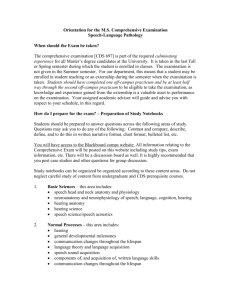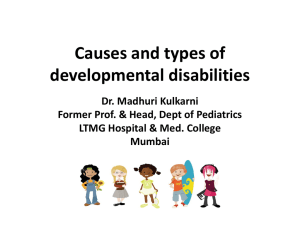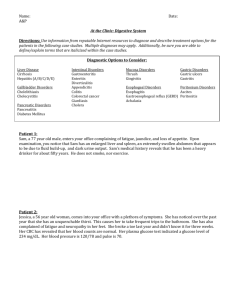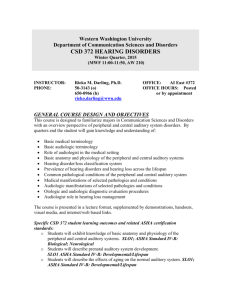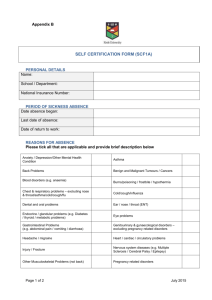Speech and Language Delays and Disorders
advertisement
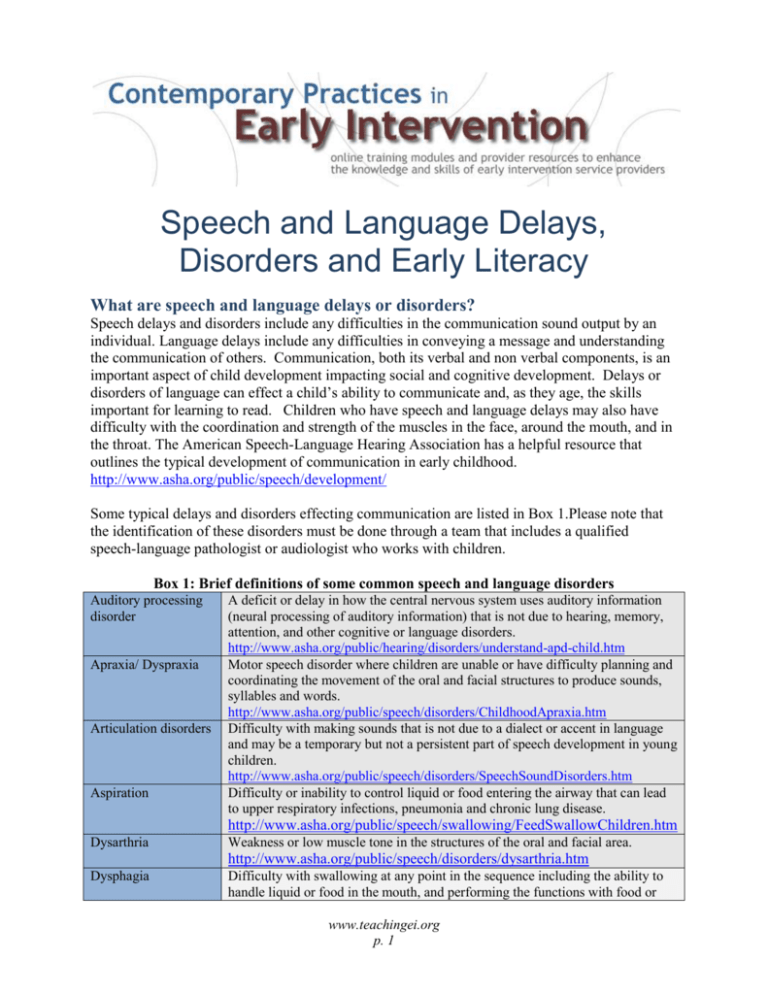
Speech and Language Delays, Disorders and Early Literacy What are speech and language delays or disorders? Speech delays and disorders include any difficulties in the communication sound output by an individual. Language delays include any difficulties in conveying a message and understanding the communication of others. Communication, both its verbal and non verbal components, is an important aspect of child development impacting social and cognitive development. Delays or disorders of language can effect a child’s ability to communicate and, as they age, the skills important for learning to read. Children who have speech and language delays may also have difficulty with the coordination and strength of the muscles in the face, around the mouth, and in the throat. The American Speech-Language Hearing Association has a helpful resource that outlines the typical development of communication in early childhood. http://www.asha.org/public/speech/development/ Some typical delays and disorders effecting communication are listed in Box 1.Please note that the identification of these disorders must be done through a team that includes a qualified speech-language pathologist or audiologist who works with children. Box 1: Brief definitions of some common speech and language disorders Auditory processing disorder Apraxia/ Dyspraxia Articulation disorders Aspiration A deficit or delay in how the central nervous system uses auditory information (neural processing of auditory information) that is not due to hearing, memory, attention, and other cognitive or language disorders. http://www.asha.org/public/hearing/disorders/understand-apd-child.htm Motor speech disorder where children are unable or have difficulty planning and coordinating the movement of the oral and facial structures to produce sounds, syllables and words. http://www.asha.org/public/speech/disorders/ChildhoodApraxia.htm Difficulty with making sounds that is not due to a dialect or accent in language and may be a temporary but not a persistent part of speech development in young children. http://www.asha.org/public/speech/disorders/SpeechSoundDisorders.htm Difficulty or inability to control liquid or food entering the airway that can lead to upper respiratory infections, pneumonia and chronic lung disease. http://www.asha.org/public/speech/swallowing/FeedSwallowChildren.htm Dysarthria Weakness or low muscle tone in the structures of the oral and facial area. http://www.asha.org/public/speech/disorders/dysarthria.htm Dysphagia Difficulty with swallowing at any point in the sequence including the ability to handle liquid or food in the mouth, and performing the functions with food or www.teachingei.org p. 1 liquid before, during and after the swallowing phase. http://www.asha.org/public/speech/swallowing/FeedSwallowChildren.htm Dysfluency Expressive language disorder Orofacial myofunctional disorders (OMD) Phonological disorders Receptive language Selective mutism A disruption in the rhythm of speech where sounds or words are repeated, run together or there is hesitation. Forms of dysfluency include stammering, stuttering and cluttering. http://www.asha.org/public/speech/disorders/stuttering.htm Better ability to understand language than communicate with language to meet their needs and express thoughts. http://www.asha.org/public/speech/disorders/ The tongue moves too far forward to properly produce speech and swallow. http://www.asha.org/public/speech/disorders/OMD.htm Difficulty or errors in making patterns of sounds together that may be seen temporarily in child language development or part of an accent or dialect. http://www.asha.org/public/speech/disorders/SpeechSoundDisorders.htm Delays or difficulties with understanding language. http://www.asha.org/public/speech/disorders/ Chronic failure to speak in social situations that disrupts school and social interaction in children lasting more than one month and is not due to other speech and language, social, cognitive or psychological disorders. http://www.asha.org/public/speech/disorders/SelectiveMutism.htm How many children have speech and language delays? Speech and language impairment is one of the most common disorders in childhood, affecting about 7% of children and one of the main reasons children are referred for early intervention and special education or related services. In 2004, the U.S. Department of Education reported that out of the 693,245 3-5 year olds receiving special education or related services under the Individuals with Disabilities Education Act (IDEA), Part B, 326,606 qualified in the disability category of speech or language impairments, which is approximately 47% of all children receiving services. Of the over 6 million children 3-21 years of age receiving IDEA, Part B services, close to a million and half children (24%) of those received speech or language services. Of the over 6 million children receiving Part B services in 2003, about 1.2% (over 71,000 children) received services for hearing impairments. Children with hearing impairments or deafness are at high risk for speech and language impairments. It is estimated that as many as 6 per 1,000 newborns have hearing loss and the average age of hearing loss diagnosis ranges from 1.5 years to 3 years of age. What are the causes of speech and language delays or disorders? There are many reasons why children might have difficulties in speech and language development. Certain injuries, disabilities and developmental disorders at the level of the ear, oral -facial structures, peripheral nervous system and the central nervous system can interfere with speech and language development. Partial or complete hearing loss due to disease, injury and congenital and genetic disorders can affect a child’s hearing and cause speech and language delays. Injury, disease or congenital and genetic disorders that affect the oral and facial structures can also affect a child’s speech and language development. Children at risk for developmental delays or who have disabilities because of conditions such as prematurity, neurodevelopmental www.teachingei.org p. 2 conditions, autism, intellectual disability, learning disabilities, and attention deficit hyperactivity disorder are at high risk for speech and language delays and disorders. http://www.asha.org/public/speech/disorders/ChildSandL.htm http://www.asha.org/public/hearing/disorders/causes.htm Which children should we be concerned about? Amy Wetherby and colleagues from the First Words Project at Florida State University (http://firstwords.fsu.edu) describes three profiles of children who demonstrate behaviors that may indicate a communication disorder: Pattern One: Children with Developmental Disabilities: Children who show delays in most areas of development. In addition to delays in using words, they also show delays in at least 2 of the following areas: emotion and eye gaze, communication, gestures, sounds, understanding of words, and use of objects. Most of these children are unlikely to catch up on their own and are often referred for early intervention services. The children in this pattern are at risk for a host of disorders including language and learning disorders, developmental delays, behavior disorders, intellectual disabilities, or autism spectrum disorders. This pattern is also seen in children who lack environmental stimulation or live in highly vulnerable environments. Pattern Two: Children with Oral-Motor and Speech Impairment includes those who show delays in using words and sounds but communicate with gestures and understand language. They play appropriately with toys and follow directions. Children in this group may have a specific speech disorder and would benefit from a comprehensive speech and language evaluation. Pattern Three: Children with a Hearing Impairment includes children who show delays in using words and sounds and receptive language but they typically use gestures to make needs known. These children may have a hearing impairment and need to be carefully evaluated by a pediatric audiologist. Although hearing impairments can be recognized in very young children, the average age they are identified is between 12 and 25 months. Children with hearing impairments also may show other developmental delays typical of the first two patterns. For any child who is delayed in the use of and response to sounds and words, it is essential to have their hearing screened. www.teachingei.org p. 3 Box 2: Early Indicators of Children at Risk for Communication Challenges (Wetherby, 2007) Behavior or Area of Difficulty Early Indicators of Children at Risk for Developmental Disabilities Early Indicators of Children at Risk for Oral-Motor and Speech Impairments Early Indicators of Children at Risk for Hearing Impairments Emotion and Eye Gaze Communication Gestures Sounds Using Words Understanding Words Using Objects Cultural and linguistic considerations in speech and language development Language and culture are intertwined and have a significant influence over parental perspectives and expectations for language development and communication in young children. Cultural differences impact how adults interact and communicate with infants and young children and have important implications for the development of speech and language skills. For example, some cultures believe that children and infants are not capable of communicating or understanding language, and therefore adults do not converse directly with their infants in these societies. Other cultures believe that talking directly to infants early is important for language development. Children in each of these cultures acquire appropriate speech and language skills but on different time lines. However, understanding the culture and preferred language of the family of children receiving early intervention services is important for discerning delays from cultural expectations and to construct the strategies for intervention that respect the family’s beliefs and expectations. Additionally, children learning more than one language demonstrate wide variety of progress in the acquisition of speech and language skills. Their progress is influenced by cultural and parental expectations, the number of languages they are learning, the contexts in which they are learning the languages and their own individual rate of learning. Some children experience delays in speech and language development or go through a period where they speak very little when learning more than one language. However, most children will learn their first words by the age of one and use two to three word phrases by the age of two as expected. They may also be more proficient in one language than another or show preferences for situations or contexts in which to use one language over another. www.teachingei.org p. 4 Promoting language development Promoting communication, language, speech, and literacy should begin at birth. Parental and caregiver sensitivity to an infants cues, responsiveness to their communicative attempts, and the provision of communication opportunities are all components of promoting language, recognizing if there is atypical speech and language development, and recognizing the need for a comprehensive evaluation and services. Infant Language Developments Sensitivity to an infants cues Newborn infants are able to perceive and discriminate sensory information and can discriminate vowel sounds, detect word boundaries and discriminate familiar voices. They can recognize familiar faces and are visually tuned into patterns and movement. They are attracted to communication and imitate adult body actions and facial expressions (Silvén, 2002). The ability of adults to recognize an infant’s cues by adults to infants is crucial for learning and social and language development. Infants communicate through a combination of sounds, facial expressions and body movements. They may communicate hunger, sleepiness or other distress with crying and leg movements. Cues that signify recognition of a familiar person or excitement may include cooing and arm movements. As an infant matures they begin to use more sounds, gestures and smiling to further their communication. Infants have a range of states of alertness that are part of receiving and communicating information. When in a quiet, alert state an infant is most receptive to information and learning. In this state, an infant looks at and follows objects and faces with their eyes, smiles and reaches and gives cues that they are interested in their environment. When they become alert and active they may be communicating excitement and joy. Cues that an infant is tired and is changing states can include multiple yawns, turning the head away or closes eyes, or begins to cry with active arm and leg movements. Responsiveness to communicative attempts Responding to cues like crying or gesturing to be picked up are important in shaping a child’s social emotional development and building a bridge between expression and understanding of communication. For example, when an infant cries, gestures with their arms to be picked up or makes sounds to get the attention of a parent and the parent responds by picking them up and saying words in soothing tones, an infant learns the reciprocity of communication, cause and effect and many other social and language skills. Children who have their cues responded to in a caring way are more likely to learn language and be well adjusted socially. Cues and responsiveness in children with disabilities Children who have delays and disabilities often have difficulty with regulating their state and provide confusing cues for parents. Early intervention providers can provide education and support for parents to better read infant cues and respond appropriately to children with delays and disabilities. www.teachingei.org p. 5 Opportunities for Communication in Natural Environments Parents and caregivers incorporate opportunities for infants, toddlers, and young children to communicate throughout the daily routine of the child. Stremel (1998) describes three basic strategies that can be used within routines to enhance communication of young children: Build anticipation and discuss environment by telling the young child what is happening and what will happen next using gestures and expression to communicate expectation, anticipation, and excitement. Engage the young child during play asking about environment and repeating answers. For example: “What do you see?” “I see a birdie” or “I see a blue birdie” etc. Interrupt the routine providing an opportunity for the child to indicate need/desire. Pausing during a game of pat-a-cake and wait until the child gestures for continued play. Providing consistent prompts, limiting variation of terminology. This helps a child anticipate the information, process the information, and reinforces common, repetitive expressions. Other language opportunities and activities o Family Activity Brochures http://gucchd.georgetown.edu/programs/cspd/object_view.html?objectID=4002 o Activities to encourage speech and language development from the American Speech-Language-Hearing Association (ASHA) http://www.asha.org/public/speech/development/parent-stim-activities.htm Early Literacy As children develop language, they are also building a foundation for literacy. As toddlers learn language and build vocabulary, they develop the ability to recognize symbols and print. It is important that early intervention providers support a family’s ability to promote the early literacy skills of young children while promoting language and communication development. For more information see the Center for Early Literacy Learning (CELL) http://www.earlyliteracylearning.org/products.php Stages of Literacy (Dunst et al., 2006) Emergent Literacy Development (12 months-30 months) o Acquisition of words o Speech for communication o Vocabulary development o Language use and comprehension o Symbol and print recognition (i.e. single letters or single numbers) o Emergent understanding of association between print and meaning Early Literacy (30 months to 5 years) o Understanding words and phonemes o Ability to play with language o Echo reading o Letter and word recognition Opportunities for early literacy promotion in natural environments (Lawhon & Cobb, 2002) Play language games, recite nursery rhymes with books and sing with children Talk with infants and toddlers about what you are doing while performing daily routines like dressing, eating and bathing Provide opportunities for young children to scribble and draw www.teachingei.org p. 6 Read aloud to infants, toddlers and young children Point to and label pictures and letters in books Respond to their verbalizations and questions Other Opportunities o Get Ready to Read http://www.getreadytoread.org/frontpage/Itemid,1/ o Literacy Center.Net- Early Childhood Education Network http://www.literacycenter.net/lessonview_en.htm# Enhancements and Alternative Means of Communication Verbal language is not the only means of communication and it is important to consider all means when promoting communication in young children. Sign language and various technologies offer important avenues for communication for children with delays and disabilities. Alternative and Augmentative Communication (AAC) There are a variety of systems available that are considered alternatives to or augment verbal language. As a group these are called Alternative-Augmentative Communication Systems (AAC). These range from simple picture boards to complex computer assisted systems. See Augmentative and Alternative Communication Connecting Young Kids (YAACK) at http://aac.unl.edu/yaack/index.html and RERC at Pennsylvania State University at www.aacrerc.com for more information. ACC Category Sample ACC systems available for children Description Examples Low tech and board systems Low tech message devices Uses materials like pictures, drawings, symbols and words that can be touched to indicate needs and wants Digitized and recorded speech output when button is depressed which can be programmed High tech systems Computerized, programmable systems with synthesized speech and computer memory which can be activated by depressing keys, eye gaze, light pointers, etc. Computer systems & Applications Computer systems and software applications that are highly programmable with voice synthesis and have more memory www.teachingei.org p. 7 Communication boards Photo books Picture Exchange Communication System Big Mac Cheap Talk Easy talk Keychain Talker Keyboard systems Crestalk ABC Lightwriter Speaking Speller Type n’ Speak Advanced systems Alpha Talk DynaVox Speak Easy Tablets E-Talk Freestyle Synergy MAAC Computer applications EZ Keys Intellitalk o Considerations for AAC : Choose the method that is: quickest and most Maches efficient communication goals Versatile Can grow with the Acceptable to child child (should last and family about three years) Does not cause Durable and portable fatigue Training for child, Dynamic or family and team is multimodal provided with Easy to use and ongoing support modify o The system should promote interaction between the child and others within a meaningful context. Speech-language pathologists, teachers, and families along with the child’s team members identify meaningful contexts for communication. Meaningful contexts for communication should be: Interactive Occur at a high Meaningful frequency through the Motivating day Valued by the child Have impact— and family and meeting the greatest need These contexts often mean interacting with music and songs, shared reading activities, and play activities that provide opportunities for ongoing social interactions. Sign language o Sign language is a means of communication through hand motions and gestures. It is also a distinct language used by people who are deaf or hard of hearing and is known as American Sign Language (ASL). For children with communication delays and disabilities, sign language is often used to augment the promotion of spoken language by pairing the signs with spoken words or phrase. o Considerations for sign language Some are concerned that using signs will minimize or supplant the use of spoken language for both children with speech and language delays and children who are deaf or hard of hearing. This is a controversial issue, but sign language has been shown to promote spoken language, decrease frustration around communication and promote early literacy skills. o More information http://clerccenter.gallaudet.edu/x18068.xml http://www.labelandlearn.com/ http://www.handspeak.com/ http://www.lifeprint.com/ www.teachingei.org p. 8 Cochlear Implants o Cochlear Implants are increasingly popular technology used with children with sensorineural hearing impairments (http://www.asha.org/public/hearing/disorders/types.htm ). According to the American Speech, Language, and Hearing Association a cochlear implant is a device that provides direct electrical stimulation to the auditory nerve. The cochlear implant does not result in "restored" or "cured" hearing. It does, however, allow for the perception of sound "sensation." o The external component of the cochlear implant includes a microphone, a speech processor, and a transmitter. The microphone looks like a behind-the-ear hearing aid. It picks up sounds just like a hearing aid microphone does and sends them to the speech processor. The speech processor is a computer that analyzes and digitizes the sound signals and sends them to a transmitter that sends the coded signals to the internal component, the implanted receiver just under the skin. The receiver takes the coded electrical signals from the transmitter and delivers them to the array of electrodes that have been surgically inserted in the cochlea. The electrodes stimulate the fibers of the auditory nerve and sound electrodes. o General considerations for cochlear implants Bilateral profound sensorineural hearing loss in a child older than 12 months Has not progressed in speech and language development with other hearing aids Family participation in terms of following pre and post implant recommendations No complicating medical or developmental history that contraindicates the procedure. Must have intact auditory nerve o Children are candidates for cochlear implants. Children as young as 14 months of age have received cochlear implants, and the potential exists for successful implantation at younger ages. It is generally agreed that the best child candidates are those who: Have profound hearing loss in both ears Can receive little or no useful benefit from hearing aids Have no other medical conditions that would make the surgery risky Are involved (when able), along with their parents, in all aspects of the informed consent process Understand (when able), along with their parents, their individual roles in successful use of cochlear implants Have (when able), along with their parents, realistic expectations for cochlear implant use Are willing to be involved in intensive rehabilitation services Have support from their educational program to emphasize the development of auditory skills. More information http://clerccenter.gallaudet.edu/x18068.xml http://www.asha.org/docs/html/TR2004-00041.html www.teachingei.org p. 9 References American Speech-Language- Hearing Association Speech-Language & Swallowing available at http://www.asha.org/public/speech/ . Understanding Auditory Processing Disorders in Children. Bellis, T. J. Available at http://www.asha.org/public/hearing/disorders/understand-apd-child.htm Childhood Apraxia of Speech available at http://www.asha.org/public/speech/disorders/ChildhoodApraxia.htm Dysarthria available at http://www.asha.org/public/speech/disorders/dysarthria.htm Dunst, C.J., Trivette, C.M, Masiello, T., Roper, N. & Robyak, A. (2006). Framework for developing evidence-based early literacy learning practices. CELL Papers. 1(1), 1-12. Available at http://www.earlyliteracylearning.org/cellpapers/cellpapers_v1_n1.pdf Jones, W. & Lorenzo-Hubert, I. (2006).Cultural and parental expectations for child development: Concerns for language development and early learning in Rosenkotter, S. & Knapp-Philo, J. (Eds.). Learning to Read the World: Language and Literacy in the First Three Years. Washington, DC: Zero To Three Press. Lawhon, T. & Cobb, J.B. (2002). Routines that build emergent literacy skills in infants, toddlers and preschoolers. Early Childhood Education Journal. 30(2), 114-118. Silvén, M. (2002). Origins of knowledge: Learning and communication in infancy. Learning and Instruction. 12, 345-374 Starble, A., Hutchins, T., Farvo, M.A. & Bitner, B. (2005). Family-centered interventions and satisfaction with AAC device training. Communication Disorders Quarterly. 27(1), 47-54. U.S. Department of Education, Office of Special Education and Rehabilitative Services, Office of Special Education Programs, 28th Annual Report to Congress on the Implementation of the Individuals with Disabilities Education Act, 2006, vol. 2, Washington, D.C., 2009. Available at http://www.ed.gov/about/reports/annual/osep/2006/parts-b-c/28th-vol-2.pdf Stremel, K. (1998). Integrating Communication into Functional Routines and Activities. [ED417572] Washington, DC: Early Education Program for Children with Disabilities, Special Education Programs. Stremel, K. Bixler, B. Morgan, S. Layton, K. (2002). Communication Fact Sheets For Parents. Monmouth, OR: National Information Clearinghouse on Children Who Are Deaf-Blind (DBLINK), Zero to Three Early Language & Literacy available at http://www.zerotothree.org/site/PageServer?pagename=key_language www.teachingei.org p. 10 Additional Resources American Speech-Language- Hearing Association (ASHA) http://www.asha.org/default.htm Speech disorders in children: http://www.asha.org/public/speech/disorders/ http://www.asha.org/public/speech/disorders/ChildSandL.htm Individuals with Disabilities Education Improvement Act 2004 http://idea.ed.gov/ National Institute on Deafness and Other Communication Disorders http://www.nidcd.nih.gov/health/hearing/asl.asp U.S. Department of Education, Office of Special Education and Rehabilitation Services http://www.ed.gov/about/offices/list/osers/index.html Center for Early Literacy Learning http://www.earlyliteracylearning.org/products.php Cite As: Georgetown University Center for Child and Human Development. Contemporary Practices in Early Intervention: Speech and Language Delays, Disorders and Early Literacy Primer. 2009. Available online at http://www.teachingei.org. www.teachingei.org p. 11



